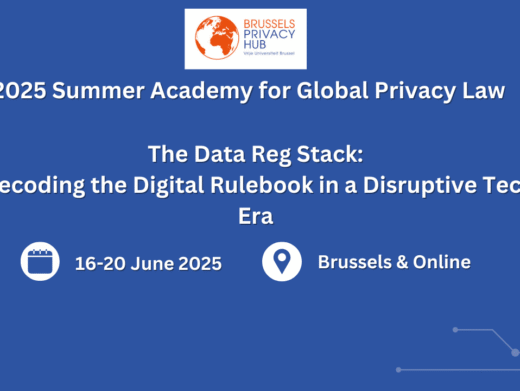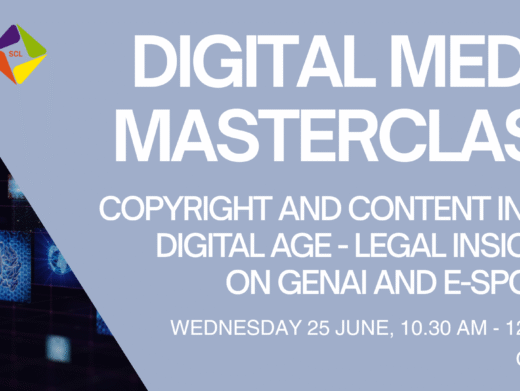There have recently been a number of CJEU referrals concerning hyperlinking and embedding or framing copyright material, and whether these acts amount to a ‘communication to the public’ under Directive 2001/29/EC on the harmonisation of certain aspects of copyright and related rights in the information society (the Copyright Directive). Following the decisions in Svensson[1] and BestWater[2], focusing on the communication aspect, more recent referrals have turned to the question of whether the way in which the copyright content was made available (with or without the rights holder’s permission) makes a difference.
So what does hyperlinking and embedding actually mean? Hyperlinking simply means providing a link to a webpage address which, when clicked on, will take the user directly to that webpage. Embedding is where a connection is set up with a video on another website, and through this the video is displayed on the other website. There is no copy of the video on the second website; rather the user will be viewing the video through a ‘frame’ to the original content by virtue of the connection.
It should be noted that all of the cases have focused on a breach of the right of communication to the public under Article 3 of the Copyright Directive, rather than the right to reproduction under Article 2. This is because neither hyperlinking nor embedding actually creates a copy of the copyrighted work that has been linked to or embedded. However, it is worth mentioning that, following the case of Newspaper Licensing Agency Ltd v Meltwater Holding BV [2011] EWCA Civ 890, where hyperlinks themselves contain elements that are the expression of the intellectual creation of the author, these may well be considered copies of a substantial part of the copyright material and therefore infringe the right to reproduction.
Given the popularity of hyperlinking and embedding, the cases are a timely reminder of the potential copyright pitfalls many will not consider. As such, this article will outline the current position by reference to the most significant cases, hoping to shed some light on when you can link and when you can’t.
Nils Svensson and Others v Retriever Sverige AB (C466/12)
Retriever Sverige AB operates a website where it provides users with hyperlinks to articles published on other websites. Svensson (and others) wrote articles that were published and were freely available on the Göteborgs-Posten newspaper website. One of the hyperlinks provided to users by Retriever Sverige AB was to the articles written by Svensson (and others) without their permission.
Referral to the CJEU
The Svea Court of Appeal referred the following questions to the CJEU for a preliminary ruling:
1. If anyone other than the holder of copyright in a certain work supplies a clickable link to the work on his website, does that constitute communication to the public within the meaning of Article 3(1) of [the Copyright Directive]?
2. Is the assessment under question 1 affected if the work to which the link refers is on a website on the Internet which can be accessed by anyone without restrictions or if access is restricted in some way?
3. When making the assessment under question 1, should any distinction be drawn between a case where the work, after the user has clicked on the link, is shown on another website and one where the work, after the user has clicked on the link, is shown in such a way as to give the impression that it is appearing on the same website?
4. Is it possible for a Member State to give wider protection to authors’ exclusive right by enabling ‘communication to the public’ to cover a greater range of acts than provided for in Article 3(1) …?
Decision
The CJEU held that the use of hyperlinks did amount to an act of communication within the meaning of Article 3(1) and, as the website was aimed at a large number of people, this satisfied the requirement of communication to a ‘public’. However, the communication was not directed to a ‘new public’, because the content was already freely available to anyone who wanted to access it. As such, there was no infringement of the communication right and therefore no requirement for consent from the authors of the content.
In response to question 3, the court held that the appearance of the copyrighted content does not make any difference to the overall position. Moreover, the court answered question 4 in the negative on the basis this would cause legislative differences and uncertainty.
Conclusion
The key appears to be how and to whom the content is available. If the Göteborgs-Posten website had a payment or member restriction on the content then, by making the articles freely available (to the wider world), Retriever Sverige AB would have been communicating to a new public (one not originally envisioned by the copyright owners) and so would have required permission for use of the copyright. As the content in this case was already freely available, no permission was required.
BestWater International GmbH v Michael Mebes and Stefan Potsch (C-348/13)
BestWater are a water filtering company who produced a short advertising video which was then embedded by the defendants onto their website. BestWater claimed this amounted to copyright infringement, particularly since the video had originally been uploaded to YouTube without their permission.
Referral to the CJEU
The Bundesgerichtshof referred the following question to the CJEU:
Does the embedding, within one’s own website, of another person’s work made available to the public on a third-party website, in circumstances such as those in the main proceedings, constitute communication to the public within the meaning of Article 3(1) of [the Copyright Directive] even where that other person’s work is not thereby communicated to a new public and the communication of the work does not use a specific technical means which differs from that of the original communication?
Decision
Referencing the decision in Svensson, the CJEU held that embedding videos freely available on sites such as YouTube does not constitute infringement of the communication right where the work is not communicated to a new public nor communicated by virtue of specific technical means different to those used for the initial communication.
The CJEU unhelpfully did not comment or advise further on the fact that the original video had been uploaded to YouTube by a third party without the permission of BestWater as the rights holder.
Conclusion
Following BestWater, embedding or framing videos will constitute copyright infringement where the content is communicated to a new public or communicated via different technical means. The case has however left open the possibility that the embedding or framing of a third-party video that is already freely available to the public, but was uploaded without the permission of the copyright holder, may constitute copyright infringement.
GS Media BV v Sanoma Media Netherlands BV and Others (Case C-160/15)
This pending CJEU referral concerns leaked photographs of the Dutch media personality Britt Dekker, taken for the purpose of publication in the Dutch edition of Playboy magazine, that were uploaded to a website called Filefactory. A Dutch company called Sanoma Media Netherlands BV then placed a hyperlink to these on their website www.geenstijl.nl.The publisher, photographer and Britt Dekker subsequently brought a claim for copyright infringement.
Referral to the CJEU
The Hoge Raad der Nederlanden has referred a number of questions to the CJEU:
1. (a) If anyone other than the copyright holder refers by means of a hyperlink on a website controlled by him to a website which is managed by a third party and is accessible to the general internet public, on which the work has been made available without the consent of the right holder, does that constitute a ‘communication to the public’ within the meaning of Article 3(1) …?
(b) Does it make any difference if the work was also not previously communicated, with the right holder’s consent, to the public in some other way?
(c) Is it important whether the ‘hyperlinker’ is or ought to be aware of the lack of consent by the rightholder for the placement of the work on the third party’s website mentioned in 1(a) above and, as the case may be, of the fact that the work has also not previously been communicated, with the right holder’s consent, to the public in some other way?
2. (a) If the answer to question 1(a) is in the negative: in that case, is there, or could there be deemed to be, a communication to the public if the website to which the hyperlink refers, and thus the work, is indeed findable for the general internet public, but not easily so, with the result that the publication of the hyperlink greatly facilitates the finding of the work?
(b) In answering question 2(a), is it important whether the ‘hyperlinker’ is or ought to be aware of the fact that the website to which the hyperlink refers is not easily findable by the general internet public?
3. Are there other circumstances which should be taken into account when answering the question whether there is deemed to be a communication to the public if, by means of a hyperlink, access is provided to a work which has not previously been communicated to the public with the consent of the right holder?
We expect the CJEU to hand down their decision by around August 2016.
Stichting Brein (Case C-527/15)
This pending CJEU case relates to the sale of a media player by an individual called Jack Frederick Wullems (also acting under the name Filmspeler) on the website www.filmspeler.nl. The product was advertised with various statements advising buyers that they would be able to watch for free content such as films and sports. This was as a result of specific software and add-ons that had been installed on the media player, with the add-ons containing numerous layers of hyperlinks that would re-direct users to third-party websites streaming content without the rights holder’s permission.
Referral to the CJEU
The District Court of Midden-Nederland has referred the following two key questions to the CJEU, amongst others:
1. Must Article 3(1) … be interpreted to mean that ‘an act of communication to the public’ within the meaning of that provision occurs if someone sells a product (i.e. a media player) on which he has installed add-ons that contain hyperlinks to websites on which direct access is provided to copyright-protected works such as films, series and live broadcasts without the right holder’s consent?
2. Is this different if:
– The copyright-protected works have not been previously disclosed to the public online at all or solely via a subscription with the right holder’s consent?
– The add-ons that contain hyperlinks to websites on which online access is provided to copyright-protected works without the rightholder’s consent are freely available and can also be installed on the media player by the users themselves?
– The website on which access is provided to copyright-protected works without the rightholder’s consent can also be located and accessed by the public without the media player?
In referring their questions to the CJEU, the Dutch court held that little clear guidance could be drawn from previous case law. They particularly highlighted that, whilst BestWater concerned a work that had been made available without the consent of the rights holder, the decision did not state that there had been no communication where a link led to a website where the work had been published without the permission of the rights holder.
We expect the CJEU to hand down their decision by around February 2017.
AEPI v livemovies.gr (5249/2014)
It is also worth noting that there has been a recent decision of relevance within the Greek Court of First Instance. This too concerned embedding content that had been uploaded without the permission of the rights holder. Following BestWater, the Greek court held that it is not of legal significance whether or not the initial communication is lawful or unlawful. The key consideration is whether there has been any circumvention of access restrictions (of the original communication). This decision does however of course apply only in respect of Greece.
Conclusion
The recent and pending decisions of the CJEU on hyperlinking and embedding have brought this area of copyright legislation to the fore. The Svensson and BestWater decisions established a solid grounding, with clear guidance confirming that there will be a breach of the copyright within a work where this has been subsequently communicated to a new public or by different technical means.
The GS Media and Stichting Brien decisions will hopefully clarify the question of whether the way in which the copyright content was originally made available matters. There will unfortunately be some uncertainty for a little while longer yet, given that these decisions are unlikely to be handed down until around August 2016 and February 2017 respectively. The table below seeks to provide a helpful summary of the current position until we hear further from the CJEU.
|
Accessibility of content |
Content lawfully or unlawfully uploaded |
Act of communication to the public? |
Do you need permission from the rights holder? |
Case |
|
Freely accessible |
Lawful |
No |
No |
Svensson |
|
Not freely accessible |
Lawful |
Yes |
Yes |
BestWater |
|
Freely accessible |
Unlawful |
To be determined |
To be determined |
GS Media and Stichting Brein |
|
Not freely accessible |
Unlawful |
Yes |
Yes |
|
Finally, it is also worth remembering that hyperlinking or embedding may constitute a breach of the terms and conditions of the website on which the copyright material was originally uploaded, and that these should also therefore be carefully checked.
Louisa Dixon is Senior Associate at Taylor Vinters with a specialism in intellectual property and brand protection. She advises on intellectual property issues, brand protection and enforcement, and commercial contracts and licences. Louisa is ranked by the Legal 500 and Chambers & Partners guides for intellectual property work and is listed as an Associate to Watch by Chambers.
Laura Rose is a paralegal in the Commercial and Technology team at Taylor Vinters, specialising in intellectual property. She advises on trade mark clearance, filing and prosecution and manages International trade mark portfolios for a number of multi-national clients.
[1] Case C-466/12, Nils Svensson and Others v Retriever Sverige AB, ECLI:EU:C:2014:76
[2] Case C-348/13, BestWater International GmbH v Michael Mebes and Stefan Potsch, ECLI, EU:C:2014:2315




